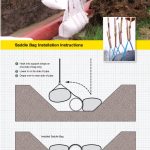Ho ho ho! Safety advice from the company whose tar sands* oil pipeline keeps leaking more than they predicted:

The free-fall calculator to which TransCanada links is kinda cool. I can punch in 174 feet and learn that (ignoring wind resistance) a fruitcake pitched from the top of the CenturyLink building in Sioux Falls (the third-shortest tallest building in a state in the U.S.) will hit the ground 3.3 seconds later at a speed of 72 miles per hour.
That concrete saddle TransCanada dropped on top of the Keystone 1 pipeline during construction at the spot that eventually leaked 5,000 barrels of oil in Marshall County three weeks ago may have fallen no more than one inch. It would have fallen for seven hundredths of a second and hit the pipe at 1.6 miles per hour. But if it weighed, say, 5,000 pounds, it would have hit that 30-inch pipe with the same kinetic energy imparted by a ten-pound hammer dropped from 43 feet above the pipe. (Ah, but a hammer drop would focus that energy over a smaller area compared to the concrete pipe… and story problems proliferate from there!)

Speaking of safety, instead of concrete saddles, TransCanada could have used rock-filled saddle bags, which reportedly are less expensive to install, require less trenching, do a better job per pound of keeping pipelines from floating up out of flooded trenches, and cause less damaging abrasion to a shifting pipeline.
*TransCanada built the Keystone 1 pipeline to carry oil from the Alberta tar sands down to U.S. refineries. But in the latest document added to the South Dakota Department of Environment and Natural Resources file on the Keystone–Amherst spill, DENR’s Brian Walsh says in a December 5 e-mail that TransCanada environmental manager Bob Baumgartner “indicated the oil released at the site was not oil sands oil—it was conventional crude oil.”
Walsh also reports that TransCanada has recovered 1,180 barrels of oil and excavated 6,000 yards of contaminated soil.
If it really was crude and not dilbit, then Trash-Can has to pay the superfund cleanup tax on every barrel on non dilbit shipped through K1,
Tar sands oil requires a much higher pressure to get through the pipe. Regular crude is safer to push through a pipe. If the tar sands comes, we will get more spills than we do now.
Are they pulling some sort of tax avoidance scam? If they put crude oil through the pipe and claim its dilbit do they avoid some taxes or are they taxed the same?
Dilbit isn’t taxed for cleanup purposes because congress decided it is not crude oil.
https://insideclimatenews.org/news/20120731/oil-spill-liability-trust-fund-coast-guard-tar-sands-refineries-excise-tax-irs-epa-enbridge
The free-fall calculator to which TransCanada links is kinda cool. I can punch in 174 feet and learn that (ignoring wind resistance) a fruitcake pitched from the top of the CenturyLink building in Sioux Falls (the third-shortest tallest building in a state in the U.S.) will hit the ground 3.3 seconds later at a speed of 72 miles per hour.
Two great ideas what to use fruitcakes for in one paragraph. Get rid of the cakes and unwanted political pests in one shot. I see numerous Nobels in your immediate future.
That’s the point I was looking for! Thanks, Mike! Now the question is, is TransCanada paying the 9-cent-per-barrel tax to the Oil Spill Liability Trust Fund on the conventional crude oil it is shipping through Keystone 1, or are they sneaking that crude through under an exemption that is incorrectly applied to everything in that pipeline?
Oil Spill Liability Trust Fund is set to expire….wait for it….wait…wait….the end of 2017 and withn wingnuts in charge and knowing how they hate making korporations lose profits by paying silly taxes, I think it is time to roll out the Endangered Species Act for this puppy.